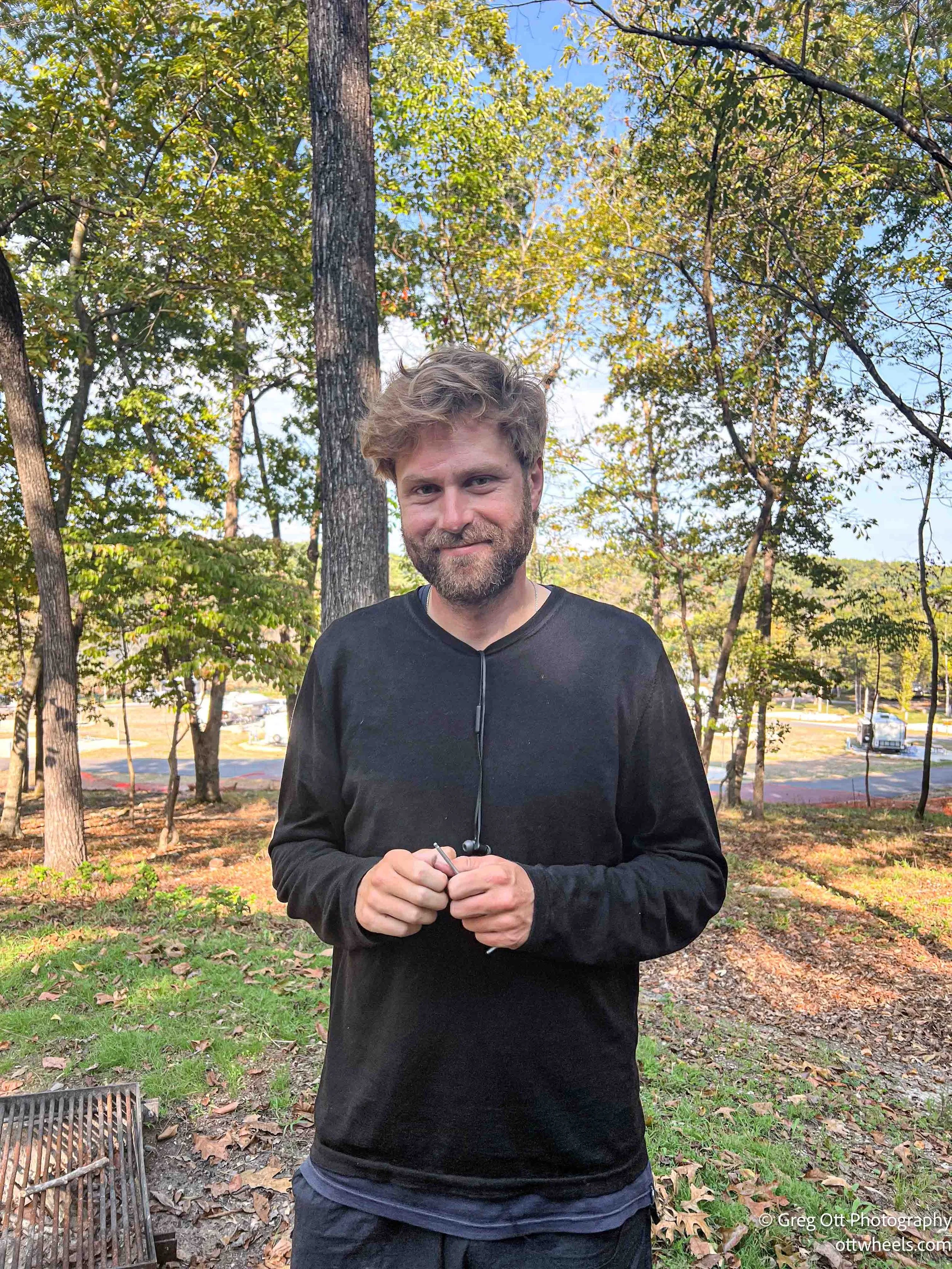Exploring Lake of the Ozarks: From Bagnell Dam to Ha Ha Tonka’s Castle Ruins
I woke at Lake of the Ozarks State Park, surrounded by the quiet stillness of early morning. The park is stunning—dense oak and hickory forests running down to the water’s edge, fingers of the lake winding through rolling hills. I hadn’t eaten breakfast yet, and as I was packing things in the van, I noticed my neighbor above me on the hill working on his bike. I walked over and asked if he needed any tools.
That’s when I met Alexis Cartier, a professional cyclist from Montreal. He was friendly, humble, and low-key—no trace of ego for someone who’s done what he’s done. I later found out he’s in the middle of an 8,000-mile solo ride across North America, connecting with local cyclists, exploring small towns, and raising awareness for sustainable travel and endurance cycling. His route stretches from Quebec all the way down through the U.S., looping across the Midwest and into the Rockies before returning north. He carries everything he needs on his bike—tools, tent, spare tires, food—and rides around 100 miles a day. You could tell immediately that he was the real deal: the lean build, the calm confidence, and the quiet focus that endurance athletes seem to carry like a second skin. His Instagram is @alexis__cartier, and following his journey gives a glimpse of what determination looks like when it meets curiosity and love for the open road.
After chatting for a bit, I headed over to the Lake of the Ozarks State Park main office. The woman at the front desk was incredibly helpful—one of those people who just loves their job. She handed me a stack of brochures, drew circles and arrows on a map, and basically planned my entire day’s itinerary. It’s always nice when someone takes the time to personalize it like that.
Bagnell Dam Historical Museum at Willmore Lodge
My first stop was the Bagnell Dam Historical Museum, located inside Willmore Lodge, perched high above the Osage River. The view from the back deck was breathtaking—blue-green water framed by steep, forested hillsides and the arc of the dam below. The lodge itself was built in 1930 by Union Electric as a guest house during the dam’s construction. Its rustic log design and massive stone fireplace give it that perfect mix of Adirondack charm and early 20th-century engineering pride.
Inside, the museum tells the full story of how the Bagnell Dam came to be. It was a monumental project for its time, completed in 1931, creating what was then the largest man-made lake in the world. The exhibits walk through every stage of the project: the surveying, the displacement of families, the logging of vast tracts of timber, the dynamiting of hills, and the relocation of communities that once sat in the valley now underwater. One display featured eight wide drawers filled with large-format photos showing the dam’s construction and the surrounding towns before they disappeared. The contrast between progress and loss was hard to miss—rows of new power lines set against abandoned homes, electricity flowing to millions while generations of families were forced to move. It’s one of those places that leaves you quietly thinking about what we trade for “progress.”
Bagnell Dam Overlook
Just around the corner is the Bagnell Dam Overlook, which gives a sweeping view of the dam and the powerhouse below. Off to one side sits a massive turbine fan from 1931, a steel giant that once spun the river’s power into light. The blades are darkened and pitted with time, but standing beside it you can almost feel the hum of history—the vibration that once ran through this metal as millions of gallons of water rushed past. I grabbed a few photos from different angles, trying to capture the scale and texture.
From there, I drove down the hill, passing the old water tower built during the dam’s original construction. I had seen it earlier in some of the historic photos inside the lodge—it hasn’t changed much. Down below the dam, the view shifts: you’re suddenly aware of just how much concrete and human effort went into taming the Osage River. I stopped there for a while, just listening to the rush of water spilling from the gates.
Missouri Department of Conservation
Next stop was the Missouri Department of Conservation Center, which felt more like a natural history museum than an office. Inside were dozens of taxidermy displays of animals native to the Ozarks—bobcats, foxes, deer, eagles, fish, and even black bears. As I walked in, the ranger was on the phone with a local farmer describing an animal in distress. From the sound of it, she thought the creature might have mange, and she calmly explained that it wasn’t necessarily fatal if the animal was left alone to recover. The man seemed intent on killing it out of fear it would infect his livestock, but she handled the conversation with patience and professionalism.
The center also had racks of free brochures, maps, and field guides—an incredible resource for anyone interested in wildlife or conservation. Outside was an 80-foot fire tower, which I decided to climb. I made it to the top, but not without stopping a few times to steady myself. The steps were narrow, and the supports were only about three feet high. Near the top, I encountered a swarm of yellow jackets searching for a nesting spot. I kept moving and eventually reached the top, grabbed a few photos, and quickly headed back down. The view was nice, but honestly, not as spectacular as I’d hoped—more treetops than sweeping vistas.
Ha Ha Tonka State Park
After a quick gas stop, I drove to Ha Ha Tonka State Park, one of Missouri’s crown jewels. The park is built around dramatic limestone cliffs, sinkholes, and natural springs.
Castle Ruins
The castle ruins are the park’s signature feature—remnants of a grand stone mansion built in the early 1900s by Kansas City businessman Robert Snyder. He dreamed of creating a European-style castle high above the Niangua River, but he was tragically killed in a car accident in 1906, just as construction was finishing. His sons tried to complete the dream, but a fire in the 1940s destroyed the interior, leaving behind only the massive stone walls and chimneys. The ruins are hauntingly beautiful, perched on a bluff with sweeping views of the lake below. Standing there, you can almost imagine what it must have been like in its brief glory days.
The Natural Bridge
A short distance from the castle is the Natural Bridge, a massive 60-foot-high span of limestone that formed when part of a cave collapsed. It looks like a stone archway suspended in the forest, with sunlight filtering through in streaks. Trails pass right underneath it, and the temperature noticeably drops as you walk below. It’s one of those geological formations that reminds you how powerful nature can be.
The Spring
From there, I followed the trail down to Ha Ha Tonka Spring, which emerges from the base of the bluff far below the castle. The water is normally a brilliant turquoise, bubbling from underground caves and flowing into the Niangua River. When I visited, the water level was low, revealing the rocky channel more than usual. It wasn’t quite as vivid as the postcard photos I’d seen, but it was still beautiful in a quieter, more subdued way. The golden hour light filtered through the trees, bouncing off the wet stones, and I grabbed a few photos before heading back up the hill. The sound of trickling water against the cliff made a fitting close to a long, full day.
I drove about an hour south toward Branson to a Missouri Conservation Area. It sat a mile and a half down a gravel road and felt completely remote. The parking area was surprisingly large, though I wasn’t sure why—there were no visible trails, just a gated road leading deeper into the area, probably for rangers. It turned out to be the perfect quiet spot to relax, make dinner, and get a good nights sleep.























